This page lists printed, e-book and audio editions of The Cyclades, or, Life Among the Insular Greeks and other books and writings by Theodore and Mabel. By clicking on the printed books in this page, you will be transferred to the page for the book on Amazon’s website. If you have an Amazon account, you can just log in and order as usual. Please note that you will be interacting directly with the Amazon website and we will be unaware of any information you enter into that site, so you can be assured of your security.
(For Theodore’s 150+ articles, papers and lectures click here)
Editions of The Cyclades, or Life Among the Insular Greeks

Bent’s classic, and rarely out of print, account of winter months in 1882/3 and 1883/4 spent exploring the Greek Cycladic islands, and still considered the must-have accompaniment to any visit, no matter how well you think you know these beguiling places. This version shown here also contains additional information about the Bents and their travel itinerary.
What the reviewers say: “These sketches of life and nature, and art in the Cyclades are unpretentious, but the subject is comparatively fresh and is admirably presented, making the book one of the most welcome of those that have recently appeared.” Morning Post – Wednesday, 8 April, 1885.
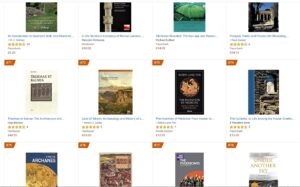
“Mr. Bent’s sketches of scenery are quiet and good. As to the treasures of folk-lore which his book contains, we can make no attempt in this notice to give the reader an inkling of them. It is a book that richly deserves to reach, and soon, a second edition; and when it does Mr. Bent will do well to have it corrected for the press by some one who understands the syntax of English pronouns. There is also a passage on the teaching of Greek at the University of Syra which needs correction. The Oxford don of to-day is not quite so easy a butt as Mr. Bent imagines; and where he less of a scholar than Mr. Bent believes, it is not for a writer who talks of Terence’s ‘Adriana’ to gird at him.” St James’s Gazette – Friday, 8 May, 1885.
“Mr. Bent’s book deserves all success, for it is the result of researches pursued in the most laudable manner. When an educated man selects for his field of observation an interesting and little-explored area of country, and, after learning the language, spends a considerable part of two winters there, living among all classes of people so as to familiarise himself with the details of their life, and to become intimately acquainted with their ideas and modes of thought, he deserves the title of an enthusiastic investigator.” Academy 27, Jan/June 1885, p. 322.
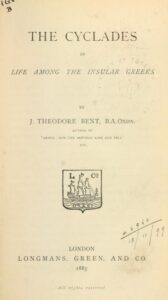
“Within the limits of Europe it is not easy to find another race concerning which so little is known as the inhabitants of the islands of the Aegean Sea. Amongst these islanders Mr. Bent, accompanied by his wife, spent two winters [1882-3/1883-4], his chief objects being the study of Hellenic archaeology and the collection of folk-lore. In both respects his residence has proved remunerative, and scholarship is the richer for his exploration. He has written, indeed, a work of far more than temporary interest… In all substantial respects the work is worthy of high praise. It is difficult, indeed, to say whether it is more interesting when from the standpoint of yesterday or that of today, for the light it throws upon the customs of the early Greek or for the proof it affords how much superstition lingers in the heart of countries avowedly Christian… A rich harvest has rewarded Mr. Bent’s labours. The part of his work which will have most permanent interest is that in which he shows what traces of the influence of Greek faith survive and colour modern life… The Cyclades is, indeed, full of interest and suggestion. To the student of folk-lore few equally more important and stimulating contributions have been made during recent years.” Anonymous review in Notes and Queries, 6th Series, xi, April 11, 1885, 299-300.
“In a small and modest form Mr. Bent has given us the results of rather arduous researches. His life in the Cyclades, in spite of all its interests, must have entailed upon him very great hardships, more especially as Mrs. Bent ventured to accompany him. The accommodation for travellers in the remoter parts of continental Greece is bad enough; it seems worse in the islands, and whatever a single man may endure, to see a lady exposed to such hardships must be trying indeed. But Mr. Bent has done his work bravely, and produced the first good sketch of the islands which has appeared for a very long time. His map and full descriptions give a life and meaning to what are mere names in history, and we now know how to differentiate Naxos, Paros, Keos, and Amorgos better than by their mere titles, or the names of the great men who chanced to be born there… Travelling among the islands being very difficult and not to be done comfortably except in a yacht, it is of the last importance to have their physical features so described that the splendid and striking features can be included in a tour without spending time upon what is merely barren rock and treeless plain. This Mr. Bent has done admirably, and gives most picturesque sketches of the weird, the waste, the wonderful, as well as the human and homely aspects of the Cyclades…. We had a word to say about Mr. Bent’s style, which is colloquial beyond the ordinary limits, but forbear to weaken in any way the favourable impression of the book which we hope to have conveyed to our readers.” Anonymous review in The Athenæum, No. 3004, May 23, 1885, pp. 658-9.
“I can do no better than recommend [The Cyclades] to other Aegean travellers, an impertinence perhaps to recommend Bent, but too few people nowadays seem to be acquainted with his work… It is the classic of Aegean travel in English and will never be superseded, for one good reason that Bent was lucky enough to visit the islands when they were still, as it were, intact and only just waking out of the sleep of centuries.” Ernle Bradford, The Companion Guide to the Greek Islands (1983, Collins, London, p. 156).
(Click here for an extended article on Bent’s The Cyclades based on the above paragraphs)

The version from Forgotten Books is a facsimile copy of the original book and contains over 500 pages. The copying has rendered the print to be quite light. There is no additional material in this edition. It is available in hard-back or paper-back versions.
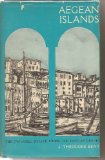 Aegean Islands (The Cyclades or Life Among the Insular Greeks)
Aegean Islands (The Cyclades or Life Among the Insular Greeks)
This hard-back version is a facsimile of the original book but with a lot of additional information, maps and pictures. It is no longer in print but single, used copies do appear on Amazon from time to time. Check if any are currently available.

This is not actually an edition of the book but a facsimile reprint of the 18-page booklet that Theodore published separately from the main The Cyclades or Life Among the Insular Greeks. It describes his archaeological excavations and finds in some of the islands.

A Spanish translation (by C. Chase and M. Calvo) appeared in 2004 as Las Cicladas o la vida entre los griegos insulares (Ediciones Clásicas S.A.; isbn 978-84-7882-542-4).
Mabel’s Chronicles edited and compiled by Gerald Brisch
 World Enough, and Time: The Travel Chronicles of Mrs J Theodore Bent Volume I: Greece and the Levantine Littoral An absolute must-have companion to Theodore’s book is Gerald Brisch’s meticulously researched and edited version of Mabel’s chronicles.
World Enough, and Time: The Travel Chronicles of Mrs J Theodore Bent Volume I: Greece and the Levantine Littoral An absolute must-have companion to Theodore’s book is Gerald Brisch’s meticulously researched and edited version of Mabel’s chronicles.
This volume is Mabel’s account of the Bents’ adventures around the Aegean and beyond, extracted from her fifteen year sequence of notebooks. It follows Mabel and Theodore to the Greek mainland, the Cyclades and the Dodecanese, as well as the northern Aegean islands. Their journeys along the Turkish littoral lead them from bustling Istanbul to provincial Mersin in the far south-west.
 Make Our Sun Stand Still: The Travel Chronicles of Mrs J. Theodore Bent. Volume II: The African Journeys This volume contains Mabel’s chronicle entries from their travels around Africa. It includes her previously unpublished account of the year they spent trekking to and from the previously unexplored ruins of Great Zimbabwe.
Make Our Sun Stand Still: The Travel Chronicles of Mrs J. Theodore Bent. Volume II: The African Journeys This volume contains Mabel’s chronicle entries from their travels around Africa. It includes her previously unpublished account of the year they spent trekking to and from the previously unexplored ruins of Great Zimbabwe.
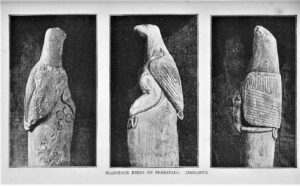
What the reviewers said: “In this new publication, Gerald Brisch presents Mabel Bent’s transcribed letters and journals from their expeditions in Egypt (1885), Zimbabwe (1891), Ethiopia (1893), the Sudan (1896), and Egypt again (1898). This is the second installment of a three-part series based on significant holdings from the Joint Library of the Hellenic and Roman Societies in London. Primarily intended as an account for family members, Bent’s writings often lack the intimacy of a personal diary. Nonetheless, her richly detailed descriptions and observations provide a rare glimpse into the experiences of a female European explorer in colonial Africa. Bent’s accounts often read like an exciting Victorian adventure novel from the pen of Rudyard Kipling or G.A. Henty… Her diary describes the personal thrill of discovering stone formations and uncovering now-famous soapstone bird carvings. She also details some of the important methodological procedures at the excavation site – an account that will be of particular interest to historical archaeologists… As previously noted, Mabel composed these writings for a family audience and she withholds many of her more private thoughts. This will frustrate the modern reader, who yearns for some display of personal reflection… Despite these minor shortcomings, Brisch and Archaeopress have done a major service by reproducing these hidden gems and rescuing Mabel Bent from relative obscurity. This collection is a valuable primary source and will be of immense interest to those interested in female travelogues, historical archaeology, or the daily experiences of European women in colonial Africa.” The Journal of African History, vol. 55/2, 2014, pp. 297-8.
 Deserts of Vast Eternity: The Travel Chronicles of Mrs J. Theodore Bent: III: Southern Arabia and Persia This volume contains Mabel’s chronicle entries from their journeys to Bahrein, Persia, the Hadhramaut, Socotra and the lands of the Fadhli and Yafai, as well as personal letters, documents, maps, and Mabel’s own photographs.
Deserts of Vast Eternity: The Travel Chronicles of Mrs J. Theodore Bent: III: Southern Arabia and Persia This volume contains Mabel’s chronicle entries from their journeys to Bahrein, Persia, the Hadhramaut, Socotra and the lands of the Fadhli and Yafai, as well as personal letters, documents, maps, and Mabel’s own photographs.
What the reviewers say: “… Brisch and Archaeopress should be commended for their attempts to bring Mabel’s work into the public eye. The diaries’ relationship with Theodore’s Southern Arabia sheds light on the monumental work Mabel undertook following his death, to bring their experiences to public attention. Although their journey through Persia was an afterthought, and their attempts to enter the Hadramaut problematic, there is much to relish in these chronicles, not least another glimpse of intrepid women explorers in the late nineteenth century.” – from Astene online archived book reviews, October 22, 2012 (accessed December 5, 2020).
“TOGETHER WITH Lady Anne Blunt, the English aristocrat who braved northern Najd, and the French archaeologist Jane Dieulafoy, whose name will for ever be associated with Persia and the discovery of Darius‘s palace at Susa, Mabel Bent belongs to a highly select club of intrepid women traveller-explorers of the late 19th century. Of the three, Mabel Bent is perhaps the least known; hence the publication of her travel notebooks is particularly welcome… this book is a valuable document on early research in Arabia.” (reviewed in Bulletin Of The Society For Arabian Studies, Number 16, 2011, pp.53-54)
The British-Yemeni Society featured the volume as With Theodore and Mabel Bent in Southern Arabia (1893-1897) in their Journal in 2010 (Vol. 18).
The ‘unpublished’ book on the Dodecanese by Theodore and Mabel

This book, compiled by Gerald Brisch, presents writings that should have formed the sequel to The Cyclades or Life Among the Insular Greeks. Between 1885 and 1888, Theodore and Mabel continued exploring the Greek islands, heading further east this time to the Dodecanese. Theodore never published his notes and articles in a single book. Brisch has brought together Theodore’s separate articles and information from Mabel’s chronicles in the form of a book – much the same way as Theodore produced The Cyclades or Life Among the Insular Greeks.
What the reviewers say: “What makes J.T. Bent’s writings stand out from the rest is that he introduces his audience to less travelled destinations – in this case the islands of the Aegean under Ottoman rule – focusing less on their monuments and history, and more on the people encountered and their local culture and idiosyncrasies… The modern reader of Theodore’s and Mabel’s travels in the Dodecanese is surely to find something of interest to him or her… Their sentiments as reflected in this collection of writings surely rested well with their intended audience, and this their candid accounts provide quite an informative, as well as entertaining, vestige of the 19th-century British imperial mindset and its approaches to the antiquities and local people they encountered.” Journal of Greek Archaeology (Archaeopress, Oxford), vol. 1, 2016, pp. 466-470.
“The book under review is essentially the second installment of [Bent’s] the Cyclades book, as it is based on Bent’s travels, along with his wife Mabel, to the Dodecanese in 1885–1888. Yet, Bent himself never published the notes from his travels to the Dodecanese as a book; rather, the editor… has collected here in a neat little volume the relevant articles published by Bent based on his travels, as well as a transcription of notes made by Mabel Bent during the same period. This is a fascinating book. It is a splendid read, as it gives the reader, very much like its predecessor on the Cyclades, an excellent insight into life in the Aegean at the end of the 19th century.” (Review, Journal of Hellenic Studies, Vol. 136, 2016, pp. 297-8)
Theodore’s other books

What the reviewers say: “Though written in a plain and simple style… ‘A Freak of Freedom, or the Republic of San Marino’… may… rank as a sketch possessing an absolutely unique interest. Of the hundreds of free republican communities, each sovereign in its own small domain, which dotted Europe in the first half of the Middle Ages, two only, Andorra and San Marino, still survive…
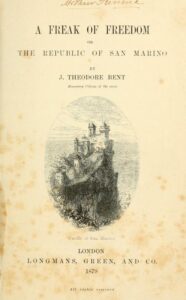 “No one, of course, who knows Italy at all is ignorant of San Marino and its history… We are not aware of any work where both are treated so neatly and so thoroughly. The pleasant chapters in which Mr. Bent describes (with the aid of some pretty drawings of his own) the precipitous slopes of the old Mons Titanus, the Città on its summit looking over… the vineyards and the corn fields which make up the rest of San Marino’s sixteen square miles, are not more successful in bringing before us the outward aspect of the little State than are the ampler historical chapters depicting the [factors] which have preserved it as an independent Republic through ten centuries of Italian story…” – The Graphic, June 7, 1879, p. 558.
“No one, of course, who knows Italy at all is ignorant of San Marino and its history… We are not aware of any work where both are treated so neatly and so thoroughly. The pleasant chapters in which Mr. Bent describes (with the aid of some pretty drawings of his own) the precipitous slopes of the old Mons Titanus, the Città on its summit looking over… the vineyards and the corn fields which make up the rest of San Marino’s sixteen square miles, are not more successful in bringing before us the outward aspect of the little State than are the ampler historical chapters depicting the [factors] which have preserved it as an independent Republic through ten centuries of Italian story…” – The Graphic, June 7, 1879, p. 558.

What the reviewers say: “Mr. Theodore Bent’s ‘Genoa: How the Republic Rose and Fell’… is a painstaking and conscientious history of a Republic which, even more than Florence, gave Europe lessons in finance. We understand his talking of ‘Shakespeare’s Merchant of Genoa’, but we wish his search among the archives had taught him not to write things down without reflection. Nevertheless a monograph on such a subject cannot fail to be full of interest; and he gives us the whole story…” – The Graphic, January 8, 1881, p. 62.

What the reviewers say: “In his ‘Life of Garibaldi’, Mr. J. Theodore Bent professes ‘to hold the balance between unfair depreciation and extravagant praise’… It is hardly fair to talk of ‘the Mazzinians like vultures trying to get hold of Garibaldi’; neither is it fair to close the record of Garibaldi’s triumphs and weaknesses with a hope ‘that he will trouble Italy no more with his presence if his visits are to be made the occasion for revolutionary outbursts.’ So far from fomenting outbursts, Garibaldi’s advice to the working-men during his visit last year to Genoa was: ‘agitate peacefully’. Mr. Bent should have abstained from sneering at the evening of a life which has certainly been useful to mankind.” – The Graphic, November 19, 1881, p. 519.
For the backstory to Bent’s Garibaldi and how his publishers, Longmans, Green and & Co., were obliged to pull the first edition, click here.

This was arguably Bent’s most successful book in terms of sales, running to several editions and generating interest in all areas of the UK in the years to come, as this notice in the The Western Morning News of August 17 1893 would suggest: “Mr. Theodore Bent, the well-known explorer, is bringing out a fresh edition of his ‘Ruined Cities of Mashonaland’. It will contain a good deal of fresh matter, the principal features of which will be confirmation of Mr. Bent’s theory of the origin of these curious remains by Professor D.A. Müller, of Vienna, and by Mr. W. St. Chad Boscawen, of the British Museum. There will be also an appendix giving an account of the progress of the South African Chartered Company, written by the secretary of the company.”
What the reviewers say: “Mr. Theodore Bent’s account of the ruined cities of Mashonaland has a peculiarity of its own, inasmuch as the explorer went in search not so much of new countries to add to his geographical bag as of the traces of an ancient civilisation which dates back in all probability to centuries before the erection of Stonehenge… Mrs. Bent shared all the perils and privations of this journey, and was the only one of the party who never suffered from fever. She did some excellent work with the camera, and was frequently able to appease an irate chieftain by simply letting down her hair, which seems to have been considered one of the greatest honours which the travellers could bestow… The book is excellently indexed and illustrated, and to the lover of Africa and of archaeology there will not be a dull pages in it.” – The Morning Post, February 14, 1893, p. 2.
“Mr. Bent is one of the most energetic of the travellers and explorers of this generation. His researches among the Greek islands and on the Bahrein group off Arabia had already placed him in the front rank, and recently, in his expeditions to the region of the ancient gold mines of Mashonaland, in South Africa, and in his more recent expedition into Abyssinia, he has scored two distinct successes.” Review by: A.L.F., Jr. in The American Journal of Archaeology and of the History of the Fine Arts, Vol. 9, No. 2 (Apr. – Jun., 1894), pp. 224-227.
The Sacred City of the Ethiopians: Being a Record of Travel and Research in Abyssinia in 1893 This is a facsimile reprint of the original edition of the book published in 1893.
What the reviewers say: “Mr. Theodore Bent is, indeed, fortunate in his knack of hitting upon half-forgotten cities and places to visit, and once more introduce to the world. A short time ago he gave us an account of the strange ruins of Zimbabwe, and now he has penetrated to the little less curious Sacred City of the Ethiopians. Other travellers may not always agree with his conclusions, but there is no denying the interest of his books and the value of his researches… An excellent map shows the route taken by the author during his four months in the country, and the illustrations are reproductions from photographs taken by Mrs. Bent, who, as usually, pluckily accompanied her husband. The book is a very fascinating record of a little-known land.” – The Graphic, April 21, 1894, p. 459.
“Mr. Bent’s explorations in Mashonaland made him desirous to investigate the traces of early civilisation in countries which had undoubtedly been under Sabaean or Arabian influence, hoping, to find buildings or inscriptions which would help to elucidate the mystery surrounding the builders of Zimbabwe. His first investigations were devoted to Abyssinia (Ethiopia), where many ancient inscriptions and important ruins were known to exist. The unsettled state of the country considerably interfered with Mr. Bent’s explorations and subjected him and his brave wife to great peril; nevertheless they succeeded in making many important archaeological discoveries.” Review by: A.W.B. in The Journal of the Anthropological Institute of Great Britain and Ireland, Vol. 24 (1895), pp.208-210.

What the reviewers say: Punch. v.118 no.3052-3077 Jan.-June. 1900, 222 (reflecting the language and attitudes of the time): “Southern Arabia (Smith, Elder) is a record of successive journeyings by Mr. and Mrs. Theodore Bent, through unfrequented districts of an ancient, still unfamiliar country. A permanent and valuable result is found in the half-a-dozen maps drawn after personal survey of pathways hitherto untrodden by a white man, not to mention a white woman. In his travelling, not always free from peril, Mr. Bent was comforted by the companionship of his plucky and resourceful wife. On the whole [one] comes to the conclusion that Southern Arabia is more pleasant to read about than to sojourn in. It teems with personages grandiloquently styled Sultans, who seem to be exceedingly mean cusses. What they want is backsheesh, and, in the words of the advertisement, they see that they get it. Whilst all the men are dirty, not all the women are beautiful. In one of many passages of vivid description Mrs. Bent says of the Arab girls, ‘Their bodies and faces are dyed a bright yellow; on this ground they paint black lines with antimony over their eyes. The fashionable colour of the nose is red; ring spots adorn the cheek.’ Thus in South Arabia is a thing of beauty a joy forever.”
We can also add with pleasure the sour and unfeeling 1901 review by D.G. Hogarth in MAN, and take the opportunity to remind readers that it was Bent who pipped Hogarth to the post at Olba in 1890, and which probably rankled with the Arabist all his life, let’s hope so in return for this ungallant review. Here it is in full:
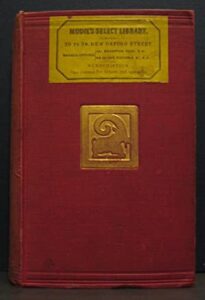 MAN, 1901, no. 23, pp. 29-30: “Southern Arabia. By Theodore Bent and Mrs. Bent, London, Smith, Elder & Co., 1900 (xii + 455, portrait, maps, and illustrations). The interest of this book consists in the Hadhramut chapters. Those dealing with Bahrein and Mascat might have have been omitted, for they add nothing to what is known from better equipped travellers. The excavations in the island were fruitless; and the descriptions of scenery and life both there and in Oman are not above tourist level. The accounts of Dhofar and the Gara country, and of the Eastern Sudan, were worth rescuing from magazine pages, since most of the ground is new and it is pretty thoroughly covered, though not of much interest. The chapters on Sokotra and the Fadhli and Yafei oases, near Aden, it is impossible to criticise in face of the pathetic appeal which closes them.
MAN, 1901, no. 23, pp. 29-30: “Southern Arabia. By Theodore Bent and Mrs. Bent, London, Smith, Elder & Co., 1900 (xii + 455, portrait, maps, and illustrations). The interest of this book consists in the Hadhramut chapters. Those dealing with Bahrein and Mascat might have have been omitted, for they add nothing to what is known from better equipped travellers. The excavations in the island were fruitless; and the descriptions of scenery and life both there and in Oman are not above tourist level. The accounts of Dhofar and the Gara country, and of the Eastern Sudan, were worth rescuing from magazine pages, since most of the ground is new and it is pretty thoroughly covered, though not of much interest. The chapters on Sokotra and the Fadhli and Yafei oases, near Aden, it is impossible to criticise in face of the pathetic appeal which closes them.
“Theodore Bent will always be remembered as the second European traveller, and the first Englishman, who ever got into the main Hadhramut valley. In attaining his end he showed immense energy and courage. He and his wife assumed no disguise, — the better plan, as many recent Arabian travellers, Pelly, Doughty, the Blunts, Huber, von Euting, and Baron Nolde have found. Mr. Bent visited the upper towns, Koton and Shibam, but did not, like his predecessor Leo Hirsch, reach Siwun and Terim, nor the reputed natural wonders of Bir Borhut. Indeed, three quarters of the great Wady have yet to be explored. Mrs. Bent was able to see a little harem life, closed to Hirsch, and, with their photographs of Koton and Shibam, the English explorers have advanced our knowledge. Considering, however, the peculiar advantage they enjoyed in being under the protection of a Sultan duly impressed with the British raj in Aden and India, and in having with them a Moslem Indian surveyor and his staff, and considering their own natural pluck and enterprise, it is the more pity they went up so ill prepared in the language and knowing so little of previous Arabian travel. In both respects they are far behind Hirsch, and their book, beside his, has little value. In the preliminary notes on the population on p. 79, the Bents perhaps show acquaintance with the standard treatise on the Hadhramut, that issued in French by the Javanese Dutch official, van den Berg, in 1886, but they never allude directly to it, and never seem to follow the obvious and useful plan of checking its hearsay statements by personal observation. Had a scholarly method of comment on Niebuhr, Wellsted, Von Wrede, van den Berg, and Hirsch (whose book appeared in 1897) been adopted as the basis of the narrative, this section of the book would have itself acquired standard authority. As it is, the travellers apparently had not realized what it was essential to observe and record, and what, on the other hand, is commonplace of all Arabian travel; and the trivialities of caravan life, already rendered more than familiar by Burckhardt, Palgrave, and Doughty, to mention only the greatest names, fill two-thirds of the account, suggesting in every paragraph unfortunate comparisons with the deeper knowledge, the truer sympathy, and the sense of style that inspired those brilliant narratives.
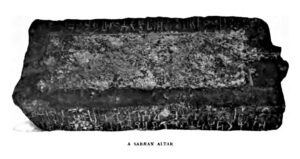
“Petty mistakes in Arabic, and even in Greek, serve as warnings against implicit faith in the anthropological evidence recorded. The most valuable savage lore is contained in the account of the naked Gara tribe, who encourage the milk production of their cows by giving them a stretched calf-skin to lick. What is said of jinns, afrits, and relics of stone worship, evinced by Bedouin behaviour to tombstones, is not new, but may be compared with Doughty passim. The list of Mahri words in use in Sokotra is welcome, so little being known of what is probably a last relic of the Sabaean tongue; but it must be accepted with reservation. The Sokotra camel marks are a very useful addition to our knowledge of primitive Arab script, but the explorers came on very few Himyaritic monuments in the Hadhramut, the best being the altar facing p. 145. It remains to be seen, however, whether the rest of the Wady will not materially add to the collections of Halévy and Glaser. One would have liked to hear more of the megalithic monuments and the rites at Kabr Houd and Kabr Saleh; but these folklore and religious questions of the interior seem to have appealed less to the explorers than the identifying of Ptolemy’s harbour in the Frankincense country. H.” [Written by the Arabist, D.H. Hogarth]
Mabel’s own books
Mabel wrote/edited and published three books after Theodore’s death in 1897 (not including Southern Arabia – see above).
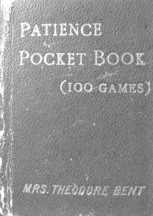 Patience Pocket Book: plainly printed (1903/4, Bristol: J.W. Arrowsmith & London: Simpkin, Marshall, Hamilton, Kent & Co. Ltd.). A tiny volume of card games; we know Mabel and Theodore took cards with them to help pass tedious moments.
Patience Pocket Book: plainly printed (1903/4, Bristol: J.W. Arrowsmith & London: Simpkin, Marshall, Hamilton, Kent & Co. Ltd.). A tiny volume of card games; we know Mabel and Theodore took cards with them to help pass tedious moments.
What the reviewers say: “Patience Pocket Book. A hundred games put together by Mrs Theodore Bent (Simpkin, Marshall, Hamilton, Kent and Co., London; J. Arrowsmith, Bristoi). 1s. —Bridge may come Bridge may go, but depend upon it, Patience goes on for ever, or, at all events, will for a very long time. This clever little book, just 3 inches by 2 inches, should find a place on every drawing-room table, and in every travelling bag when starting for abroad. The preface describes the principles on which the details of the hundred games are condensed into few words, and the rules and abbreviations are so simple that a child could easily compass them. The result is that the several kinds of Patience are described in as few words as it is possible, and the selection is a most excellent one. At hotels at home and abroad you see people with their Patience boards, devoting their evenings to the game; and here is a friend and companion that will make the players acquainted with many sew variations, and give plentiful amusement. Mrs Theodore Bent is wont to do what she undertakes well, a fact that this little book amply proves.” – The Queen, the Lady’s Newspaper (Jan. 16, 1904, page 105).
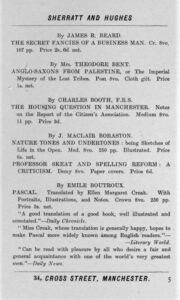 Anglo-Saxons from Palestine; or, The imperial mystery of the lost tribes (1908, London: Sherratt & Hughes). After Theodore’s death, Mabel, distracted, absorbed herself in various odd causes, including the bizarre, sinister and still active British-Israeli movement. She contributed this misguided volume – it is absurd and, fortunately, almost impossible to read or obtain today. What we can show you for now is the strange book’s announcement in British Birds for Cages, Aviaries, and Exhibition, by Sumner W. Birchley, published by Sherratt & Hughes in 1909.
Anglo-Saxons from Palestine; or, The imperial mystery of the lost tribes (1908, London: Sherratt & Hughes). After Theodore’s death, Mabel, distracted, absorbed herself in various odd causes, including the bizarre, sinister and still active British-Israeli movement. She contributed this misguided volume – it is absurd and, fortunately, almost impossible to read or obtain today. What we can show you for now is the strange book’s announcement in British Birds for Cages, Aviaries, and Exhibition, by Sumner W. Birchley, published by Sherratt & Hughes in 1909.
What the reviewers say: “The late Mr. Theodore Bent was a most intrepid traveller and on most, if not all of his Expeditions he was accompanied by his wife. During their wanderings in Southern Arabia, the Sudan and Sokotra, the latter seems to have brooded on the question of the lost Ten Tribes, and the result of such meditation is now recorded in a little book, written mostly in Jerusalem, entitled: Anglo-Saxons from Palestine, or the Imperial Mystery of the Lost Tribes. The conclusion to which Mrs. Bent has come is that the lost tribes are to be found in Britain. She says: ‘The Ten Tribes are undoubtedly somewhere on the face of this earth, and if they are not the British who are they ? Try to fit the description on any other nation, and you fail’. Mrs. Bent has been much impressed by the writings of Mr. Edmund Hine on the subject, but, though, like him, she quotes a multitude of verses from Holy Writ, we cannot see that she has proved her contention.” – Luzac’s Oriental List and Book Review Quarterly, Vol. XX, 1909, pp. 115-116.
“Mrs. Theodore Bent has done such good work in exploring the lesser-known parts of the earth, that it is a pity to find her wasting her energies in pursuing the will o’ the wisp of the Anglo-Israelite theory. It would be unkind to criticise this little work, which merely follows the accepted type of books of its class, in straining the meaning of obscure prophesies to defend a position for which sober history gives hardly any support. We need only criticise one remark, “As the House of Israel is not amid the House of Judah at the present time,” says Mrs. Bent, “it must necessarily be somewhere about in the world.” Surely the author is aware that tribes, nations, and States have died out altogether more than once in the annals of the world; her “necessarily” is, therefore a non sequitor.” – The Globe Literary Supplement, 6 January 1909.
 The Garden Tomb, Golgotha and the Garden of Resurrection (with Arthur William Crawley-Boevey and Miss Hussey (c. 1920, Jerusalem/London: Committee of the Garden Tomb Maintenance Fund). In a way associated with the above, and, again, deriving from the decade or so Mabel spent visiting the ‘Holy Land’, this little guide to the ‘Garden Tomb’ is aimed at like-minded visitors to the site, for which there is little, if any, archaeological evidence.
The Garden Tomb, Golgotha and the Garden of Resurrection (with Arthur William Crawley-Boevey and Miss Hussey (c. 1920, Jerusalem/London: Committee of the Garden Tomb Maintenance Fund). In a way associated with the above, and, again, deriving from the decade or so Mabel spent visiting the ‘Holy Land’, this little guide to the ‘Garden Tomb’ is aimed at like-minded visitors to the site, for which there is little, if any, archaeological evidence.
Audio editions

FACSIMILES
The Bents’ notebooks and diaries
The originals are held in the archive of the Hellenic Society, London. They have been scanned and are now available on open access.

